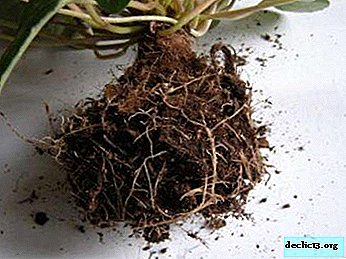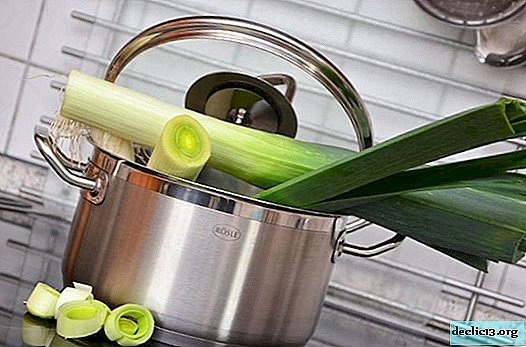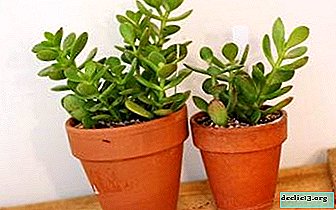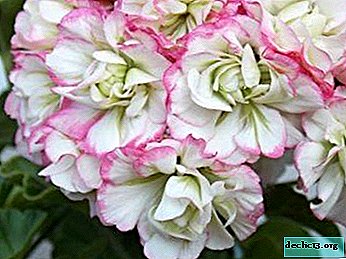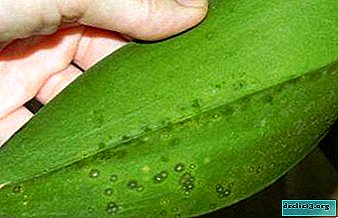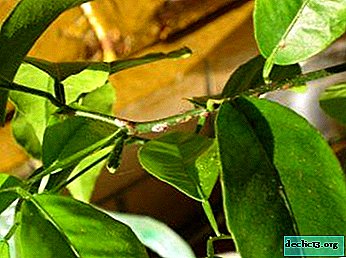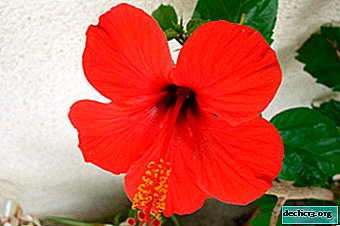How to recognize diseases of garden and indoor roses and rid flowers of pests? Causes and prevention
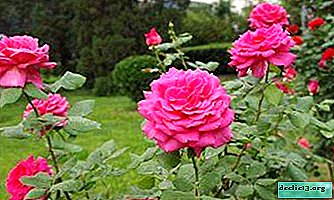 The queen of flowers - a rose - is distinguished not only by its beauty and aroma, which will not leave anyone indifferent, but, unfortunately, by its fragile health.
The queen of flowers - a rose - is distinguished not only by its beauty and aroma, which will not leave anyone indifferent, but, unfortunately, by its fragile health.
In this article, we will consider the main signs of rose diseases, their treatment and preventive measures.
Also consider a list of dangerous insects, methods of dealing with them, for which the rose is an excellent food.
Visual inspection
It is necessary to distinguish between the symptoms characteristic of the defeat of viruses (as well as bacteria and fungi) and the signs of damage by various pests.
A sick rose can be recognized:
- on dark brown ulcers on the stems;
- red and beige spots on the leaves;
- whitening or yellowing of leaves;
- powdery, gray or brown bloom on the leaves.
A plant suffering from pests is different:
- "lace" leaves "(the so-called figured gouging);
- "moves" inside the stems and leaves, gnawed by insects;
- damaged buds and flowers;
- destroyed by pestles and stamens.
Reasons and background
 There are certain prerequisites that make a plant vulnerable to infections and parasites.. This is, first of all, the negligence of the grower himself, who did not take care to provide the roses with the necessary illumination and other conditions.
There are certain prerequisites that make a plant vulnerable to infections and parasites.. This is, first of all, the negligence of the grower himself, who did not take care to provide the roses with the necessary illumination and other conditions.
The “Queen of the Garden” requires constant sunlight, well-drained soils (with an acidity of pH 6.5-7.6), timely and accurate implementation of preventive measures. If these conditions are not met, diseases will not be long in coming.
Indoor roses are sick from:
- Too high temperatures in the room;
- dry air
- prolonged exposure to open sunlight;
- drying out of the soil;
- dust.
In a word, one common reason - our carelessness. The danger of a disease for a rose is not only that it begins to lose its decorative effect. A flower can die, and the disease spreads to the nearby growing plants.
Description of diseases and methods for their treatment
Next, we will provide a description of the most pressing problems of garden and indoor roses, show how flowers affected by diseases look in photographs, and also talk about effective methods of treating them.
Powdery mildew
It is characterized by a whitish bloom, which from June to August affects leaves, buds and young shoots.What to do:
- In the autumn, cut out spoiled shoots, burn all fallen leaves, dig the soil.
- In the spring, spray sleeping buds with a two-percent solution of copper sulfate (at the rate of 200 g per 10 liters of water) or three-percent iron sulfate (300 g per 10 liters of water).
- Throughout the season, with the exception of the flowering period, spray the rose garden with a solution of soda ash and soap (50 g of soda, 50 g of soap in 10 liters of water).
A folk remedy such as dung infusion helps well.
- Half fill the bucket with dung or grass.
- Add water to the top, let it brew for three days.
- Then strain, dilute three times with water and start spraying.

Rust
The presence of yellow-orange tubercles, which are formed in early May on green shoots and leaves from above, is characteristic. Pustules containing fungal spores appear below the leaves.
What to do:
- Immediately cut and burn affected parts of plants.
- To carry out prophylaxis in the form of treatment with preparations containing mancozeb.
- At the very beginning of the season, carry out loosening, mulching, treatment with iron sulfate.
Do not overfeed flowers with nitrogen fertilizers.

Necrosis
Complete or partial necrosis of flowers, usually observed in the case of severe acidification of the soil.
What to do:
- In case the root is completely rotted, the only thing left is to dig out the rose and throw it away.
- If root necrosis has spread greatly, but does not require digging, the rose should be pruned as extensively as possible.
- Without regret, remove branches from the periphery, they will still die off.
In order to provide oxygen access to the roots and thereby weaken the destructive process, deep fork tilling on the crown projection is necessary. In case of cortical necrosis, it is necessary to timely treat cracks with preparations with antifungal and antimicrobial components.

Yellowing
Rose leaves turn yellow most often due to unbalanced nutrition.
What to do: adjust the "diet" of flowers for sufficient content:
- nitrogen;
- phosphorus;
- potassium;
- gland.
This applies not only to garden roses, but also to indoor roses.

Withering
There is deformation and drying of leaves, overgrowth of young shoots.
What to do:
- Trim and burn affected shoots.
- Dig out completely wilted plants.

Drought
Drying of stems, leaves and root system.
What to do:
- Spill not only superficial, but also lower layers of the soil.
- Defend tap water for two to three days.
- Water the flowers not with a hose and not with a strong stream, but with a drop method or from a watering can.

Blackening
Characterized by:
- brown rounded concave spots;
- ulcers of black-brown color, formed on the site of dead tissue;
- the gradual drying of the stems;
- blackened leaves.
The most common cause of blackening is bacterial cancer.
What to do:
- In all cases - get rid of the affected parts of the plants on time.
- The remaining healthy portion should be disinfected with a 5% solution of copper sulfate.
- Lubricate ulcers and places of cuts with garden var.

Gray rot
Brown fungal plaque is typical for garden and indoor roses.
What to do:
- Limit watering in protected ground.
- Create ventilation.
- Regularly remove the affected areas from the bushes.
- Spray roses with euparen, foundationazole and other fungicides every two weeks until the coating disappears.
- Apply fertilizers containing manganese.

Root rot
With the disease, the bush fades completely, for no apparent reason.What to do: since the causative agent of the disease has the property of “wintering” on plant debris, prophylaxis is necessary. Namely:
- Cut off all diseased shoots.
- Clean and burn fallen leaves.
- Reduce watering rates, especially in rainy weather.
- Plants are systematically sprayed with a biofungicidal preparation.
Use the folk method - spray the rose garden with decoctions of horsetail and nettle.

Spotting
Called by the fungus Marssonina rosae. This disease very quickly destroys the plant.
What to do:
- Cut off all affected leaves, get rid of absolutely all fallen leaves.
- Every 7 to 12 days, treat the rose several times with copper-containing preparations, fungicides.
- Between treatments spill the soil with Fitosporin-M 2 to 3 times.

Viral infection
The banding virus can be identified by a dark border on the leaves and brown spots on the shoots.
What to do: the disease, unfortunately, is incurable. Therefore, it remains only to cut out the infected areas. Dig up and destroy a heavily damaged rose bush.
After work, be sure to disinfect the instruments with alcohol or potassium permanganate.

Noncommunicable diseases
- Root Jamming.
- Aging.
- Lack of nutrition, etc.
What to do:
- To shade plants during the adaptation period, to carefully look after.
- Fertilize roses several times a season with potash and phosphorus fertilizers and trace elements.
- Avoid overuse of pesticides.
List of Dangerous Insects
The most dangerous pests are during the growing season.Buds, shoots, young leaves and flowers - a favorite food of insects and their larvae. So the rose needs the greatest protection during this period. Next, we present a description of dangerous pests and photos of the affected plants and tell whether they are being treated; Learn how to get rid of these problems and step-by-step instructions on how and how to treat indoor and garden flowers.
Rose aphid
The increased activity of ants in the rose garden is the best evidence that aphid colony appeared here.
What to do:
- Treat roses with contact insecticides. This should be done in early spring, before the swelling of the kidneys.
- In a later period, apply kalbofos, horn, actellic, anti, metathion.
- You can use the alternative method - spraying with kerosene (based on 2 g of kerosene per 10 liters of water).

Rose circadian
The presence of this pest is easily recognized by the "marble" leaves, covered with small whitish spots.
What to do: during the mass emergence of larvae, conduct two treatments with insecticides with an interval of 10 to 12 days. Treat not only the rose garden, but also the territory adjacent to it.

Slobbering pennies
You can recognize by salivary foam, which is located in the axils of the leaves and in which the larvae live.
What to do: According to the scheme proposed above, spray with insecticides.

Spider mite
The tick sucks the juice from the leaves, leaving light spots at the injection site, as well as cobwebs and traces of life.
What to do:
- Spray the flower bed with acrex (concentration 0.08%), isophene (0.05%), omite (0.1%) and other acaricides.
- Spray the lower surface of the leaves with cold water several times a day.

Leaflets
These caterpillars appear in early spring and damage freshly opened buds, later on leaflets and young tender shoots.
They create a refuge for themselves in twisted leaves that are entangled in cobwebs.. Caterpillars twist leaves to form pupae. Throughout the month, caterpillars can destroy most of the roses.
What to do. Collect caterpillars from the bush with your hands and destroy. With large settlement - in the spring, before the buds open, spray the bushes with a pesticide.

Sawflies
Caterpillars destroy shoots, making moves inside them and developing there.
What to do: preventive measures in the fall - dig up the soil under the bushes. In this case, the pests will be on the surface and freeze. If the invasion of the caterpillars could not be avoided, the plants should be sprayed with a pesticide, and the settled shoots should be cut and burned before the larvae emerge from them.

Bronze and deer
Both beetles eat petals of rose flowers, eat stamens and pistils. Flowers of light tones suffer more from them.
What to do: manually collect beetles in the early morning when they are sitting on flowers motionless.

What do indoor flowers suffer from?
Room relatives of the "Queen of the Garden" have identical diseases. Indoor roses suffer from powdery mildew, downy mildew (in which only the underside of the leaves is covered with plaque), spotting and rust. As with street flowers, home roses need to be treated by:
- removal of affected shoots, leaves and buds;
- fungicide treatment;
- spraying with preparations containing copper.
Diseases of home roses are much easier to minimize. The most important thing is to breed them in well-ventilated cool rooms and provide them with bright diffused light.
Carrying out measures for the prevention and treatment of roses from diseases, protect your health. Using pesticides, use respirators and rubber gloves, do not exceed the indicated doses of drugs. After work, be sure to wash your hands and face with soap.



